The 15 Best Home Wind Turbines (Residential) – Are you tired of the ever-rising power bills? Wind energy is an amazing choice that may assure a big decrease in your electricity expenses. Let’s examine together the different home wind turbines available for usage at home. For these modest home wind generators, they may be erected anywhere on your land and can help you cover either part or your complete energy demands.
How We Selected The Best Home Wind Turbines (Residential) in 2024
At Linquip, we understand the importance of choosing the right home wind turbine. The selection process involves a lot of research and analysis, and we’ve dedicated hours to selecting the best products in the market. Our team has analyzed more than 15 webpages and hundreds of products, consulting with our industry experts, reviewing previous experiences, and paying close attention to customer reviews.
We’ve compiled a list of the best home wind turbines for residential use, taking into account factors such as performance, durability, ease of installation, maintenance, and overall value for money. We’ve evaluated each product according to their specifications, features, price, brand reputation, warranty, and customer feedback, ensuring that every product on our list delivers on its promises and meets our high standards.
Our experts have years of experience in the renewable energy industry and have worked with numerous wind turbine companies, which has given us an in-depth understanding of the market. We’ve taken into consideration the unique requirements and limitations of different homes, and we only recommend products that are suitable for residential use.
At Linquip, our goal is to provide our customers with the best products that meet their needs and exceed their expectations. We’re committed to providing comprehensive product information, expert advice, and excellent customer service. You can rest assured that our recommendation is based on extensive research and our experts’ years of experience in the industry.
In conclusion, we’ve carefully selected the best home wind turbines that deliver on performance, durability, ease of installation, maintenance, and value for money. We believe that our recommendation is the best choice for residential use, and we’re confident that you’ll be satisfied with our selection.
The 15 Best Home Wind Turbines are:
- Automaxx 1500W Wind Turbine Generator Kit Buy Now
- Tubo-Int 1000W Wind Turbine Generator Kit Buy Now
- Nature Power 70701 Marine-Grade Wind Turbine Buy Now
- Windmax HY400 Residential Wind Turbine Kit Buy Now
- Pikasola 400W Wind Turbine Kit Buy Now
- Primus Wind Power Air 40 Wind Turbine Generator Buy Now
- Giosolar 3,000W 48V Hybrid Solar Wind Backup Power Kit Buy Now
- Eco-Worthy 1,400W Wind Solar Power Kit Buy Now
- Auecoor 1,200 Watt Wind and Solar Power K Buy Now
- Tumo-Int 400W Vertical Wind Turbine Generator Kit with Controller Buy Now
- Pacific Sky Power Survival Wind Turbine Generator Buy Now
- Ramsond Atlas LM3500 Wind Turbine Buy Now
- Northern Power Systems – WindGen 1200 Buy Now
- Wind & Sun – XLE Series Buy Now
- Bergey Wind Power – BWP-1850 Buy Now
Linquip provides all the information you need about home wind turbines. At Linquip, we try to address all of your needs related to wind turbines. Start by exploring “What Is Wind Power?” at Linquip to learn the basics.
Basics of Home Wind Turbines
Wind turbines for the home are a scaled-down replica of the enormous turbines that may be found along coasts and rural routes. Homeowners may capture the wind’s kinetic energy and create their own renewable power using the same technology as commercial wind farms.
If you live in a place where there is enough wind, a wind turbine might help you save 50 to 90 percent on your power expenses. They also help you reduce your carbon footprint and give you reliable power during blackouts and other interruptions on the electrical system.
We can assist you in fulfilling part of your electricity demands with environmentally friendly, cost-effective, and emission-free energy. There are many alternatives for individuals seeking house wind turbines, so we made it easy for you by examining six of the top home wind turbines on the market.
Are you looking for home wind turbine devices and equipment? Linquip’s free database lists the Home Wind Turbine Products. Are you trying to find the best home wind turbine equipment and device prices? Using Linquip, you can send a request and receive quotes from all Wind Suppliers and Companies for free.
What is a Domestic Wind Turbine?
A domestic wind turbine also called a house wind turbine, converts wind energy into clean energy for your home. It looks like a smaller replica of the much larger wind turbines you’ve probably seen in fields or just off the coast. Although the essential technology is the same, residential wind turbines are smaller.
How Does a Home Wind Turbine Work?
Like larger wind turbines, home turbines capture the breeze’s energy and convert it into power. When the wind blows, it pushes the turbine’s blades and causes them to spin. This spinning motion drives a shaft within the turbine, which powers a generator, which converts the spinning motion’s kinetic energy into electricity.
Wind turbines are typically quite tall and feature massive blades to capture as much wind power as feasible. Obviously, you can’t build one on the same scale in your backyard, so you won’t capture nearly as much energy. As a result, household wind turbines are only advised for persons who live in remote, windy places.
Types of Home Wind Turbines
In general, there are two types of wind turbines that may be erected at home.
Wind Turbines on The Roof
Small wind turbines, similar to solar panels, sit on top of your roof. The optimal height for them to take advantage of the wind blowing over your house is on the roof. Installing them is typically less expensive than installing solo turbines. However, because they’re smaller, they’re generally less powerful, generating only 1-2 kW.
Wind Turbines That are Stand-Alone or Installed on a Pole
Free-standing wind turbines are expected to be more powerful than roof-mounted turbines — but only if they’re installed correctly. They function best in a large, open place with nothing to slow the wind down, such as a large field — or even better, on top of a hill.
A solitary turbine may not be suitable for you unless you have this type of land accessible near your home. They’re frequently pricier as well. However, if you do have the room and the funds, the good news is that it has a higher chance of powering your complete home than a roof-mounted system.
What Are the Benefits of Powering Your Home with Wind Energy?
Advantages of Home Wind Turbines
- Wind turbines are low-carbon: they’re a green, renewable energy source that doesn’t emit carbon dioxide, which contributes to the climate issue.
- They can help you save money by reducing your energy expenses by producing your own electricity. Furthermore, the Smart Export Guarantee may be able to compensate you.
- They also look cool: if you’re willing to spend some money, there are several architecturally inventive wind turbine designs available. Why not take it a step further and make your house as modern as its energy?
Disadvantages of Home Wind Turbines
- The initial investment is high: a 6kW pole-mounted system might cost between 32,000 and 47,000 dollars.
- They aren’t appropriate for every home: residential wind turbines aren’t for everyone. To power them, you’ll need the correct wind speed, which means you’ll need a lot of open space, which is normally only available in rural residences (sorry, city residents!).
- Wind energy is environmentally friendly, clean, and long-term. However, it is neither the cheapest nor most convenient alternative, especially for city dwellers. As a result, many eco-warriors who own a home opt for solar panels instead. These may be mounted on your roof to save space and can be used anywhere (not only on the top of a windy hill!).
Can I Put a Wind Turbine on My Property?
The first thing to consider when deciding whether or not a home wind turbine is right for you is how much room you have. Remember that the higher you set your wind turbine and the larger its blades are, the more energy it will gather.
Do you have enough room? That’s fantastic, but hold on a second! Before you go building a wind turbine on your lawn, you’ll need to answer two more essential questions.
What’s Your Wind Speed?
To be cost-effective, wind turbines require an average wind speed of 5m/s (meters per second).
Do you have any idea how fast the wind is surrounding your house? The best approach to find out is to use an anemometer (a handy instrument that measures wind using sonic waves) or a wind gauge.
The Energy Saving Trust suggests putting one of these devices where you want to put your wind turbine and keeping it there for a few months. This will provide you with the most accurate information to assist you in determining whether a household wind turbine is right for you. You may either do it yourself or hire someone to do it for you.
For a Home Wind Turbine, Do You Need to Get Planning Permission?
In many countries, a roof-mounted wind turbine does not require planning authorization as long as it follows a set of guidelines, which include:
- The installation complies with MCS requirements.
- You own a detached house in a neighborhood with other detached dwellings.
- You’re just going to put up one turbine.
- If you don’t already have an air source heat pump, now is the time to get one.
- The turbine does not rise more than 3 meters over the top of your chimney.
If you’re unsure about adding a wind turbine to your home, get guidance from an expert or a local shop. You are also encouraged to check out our Wind Turbine Providers on Linquip for more information to fulfill all of your needs.
1. Automaxx 1500W Wind Turbine Generator Kit

Specifications
| Wind speed rating | 31mph |
| Energy output | 1500W |
| Over-speed protection | Yes |
General Descriptions
The following are some of the reasons why we chose this excellent turbine kit as our best home wind turbine option.
- Beginners will love this:
Everything you’ll need to get started is included in the kit, which is very useful for novices. Because it has a built-in charge controller, customers won’t have to worry about difficult wiring or installation. The Automaxx system immediately begins storing clean power after attaching the turbine and connecting it to a battery.
This kit includes everything you’ll need, including all screws, nuts, and spacers, and you can put it together and take it apart fast and easily. In fact, Automaxx places a premium on simplicity of installation since it thinks that green energy should be available to everyone.
- Impressive Longevity:
Automaxx went above and above in terms of durability to ensure that this turbine kit would survive. The turbine’s primary housing is made of high-quality polypropylene, while the blades are made of sturdy yet lightweight fiberglass.
This turbine is weather-resistant from its blades to its exterior wiring, with a UV-resistant covering to avoid sun damage and degeneration.
- Extras include:
Because your turbine has built-in overcharge and over-speed protection, you won’t have to worry about disassembling it in extremely windy circumstances, which can be an unpleasant and time-consuming concern for some turbines that aren’t designed for high-wind exposure. The integrated charge controller also features automatic voltage protection, ensuring that whichever battery you match with your turbine kit will endure as well. Operators can also use a manual braking switch in an emergency, which is essential when disassembling or relocating the device.
Bluetooth connectivity and a built-in Amp meter display are among the kit’s noteworthy supplementary features, which are generally reserved for high-end, professional turbines.
2. Tubo-Int 1000W Wind Turbine Generator Kit

Specifications
| Wind speed rating | 28mph |
| Energy output | 1000W |
| Over-speed protection | Yes |
General Descriptions
Tumo-1000W Int’s turbine kit just missed out on the top slot. A highly efficient and adaptable unit might be the ideal solution for your needs if you reside in a location with modest wind speeds but still want to benefit from this environmentally friendly energy source.
- High Productivity:
The three lightweight injection-molded blades of the turbine each have a distinct aerodynamic profile that aids in the generation of power at low wind speeds. While the turbine operates better in stronger winds, the fact that the blades are designed for low-speed winds means that your turbine will generate power more frequently, resulting in a lower yearly electricity bill.
- Sturdy and long-lasting construction:
The turbine’s complete exterior has been engineered to survive at least 15 years without substantial wear. The outside casing of the turbine is corrosion- and weather-resistant, allowing it to operate in temperatures ranging from -40°F to 80°F. While some household wind turbines require disassembly throughout the winter, the Turbo-Int can operate even when temperatures dip well below freezing.
- Extras include:
The sleek and effective controller unit is the first thing we recognized about this turbine kit. It may transform the turbine’s alternating electricity into direct current, which can then be stored in a battery. It also has electromagnetic over-speed and overcharges safety, so you won’t have to worry about your turbine or battery system being damaged by severe winds.
As an added benefit, the lightweight blades and turbine shell allow the complete unit to run at a low volume. Because of the aluminum housing, the turbine weighs significantly less than similar-sized devices, resulting in less vibration and noise.
3. Nature Power 70701 Marine-Grade Wind Turbine

Specifications
| Wind speed rating | 28mph |
| Energy output | 2000W |
| Over-speed protection | Yes |
General Descriptions
Corrosion might be a problem if you live in a humid environment or in a region that gets a lot of rain. If you’re searching for a turbine that can survive rain and moisture buildup, the Nature Power 70701 is a great option.
- Corrosion-resistant and low-maintenance:
In even the wettest conditions, a high-quality, marine-grade coating protects the turbine and resists corrosion. Coastal homeowners and yacht users love the Nature Power 70701 as an emergency power source.
The carbon fiber composite blades and industrial-strength die-cast aluminum body function at low vibration levels and require very little maintenance. The unit’s rugged construction allows it to resist wind gusts of up to 110 miles per hour, which would easily damage less robust turbines.
- Conversion Rate Is High:
With just 28 mph winds, the turbine can generate up to 2000W, and it can start generating electricity in just 7 mph. The 3-phase synchronous generator can charge a 12V battery in a fraction of the time other turbines of similar capacity can.
4. Windmax HY400 Residential Wind Turbine Kit

Specifications
| Wind speed rating | 28mph |
| Energy output | 500W |
| Over-speed protection | Yes |
General Descriptions
This device was chosen as our best mid-range selection because it strikes the ideal combination between quality and price. While it performs well in high-wind circumstances, it also performs well in low-wind settings, making it ideal for beginners seeking a dependable and efficient turbine to help them lessen their dependency on the grid.
- Design that is both dependable and efficient:
One of the most appealing features of the Windmax HY400 is its maintenance-free construction. The device may be left alone after installation, thanks to the lightweight turbine blades and innovative electromagnetic over-speed controller. This turbine’s ability to provide continuous energy without the need for adjustments or maintenance explains why it’s such a popular choice, especially among beginners.
- Outstanding Longevity:
Windmax employed a mixture of blended nylon and reinforced fiberglass to manufacture the blades, which is noteworthy given that this unit may be regarded as a mid-range turbine. This turbine is one of the most reliable and strong turbines in its price range when paired with an injection molded thermoplastic housing.
5. Pikasola 400W Wind Turbine Kit

Specifications
| Wind speed rating | 29mph |
| Energy output | 400W |
| Over-speed protection | Yes |
General Descriptions
Given that many individuals are turning to wind power to lower their monthly electricity costs, it only makes sense to hunt for a cost-effective solution. The Pikasola turbine kit is one of the most cost-effective home wind turbines on the market, and it works admirably.
- Extremely Efficient performance:
A three-phase magnetic synchronous motor is used to generate power in this compact turbine effectively. The machine shuts off when the battery is fully charged, thanks to a fully integrated voltage regulator.
The current and voltage are controlled and adjusted by an internal computer to ensure that the turbine operates at maximum efficiency at all times.
- Cost and quality are balanced:
Despite its high-quality aluminum and stainless steel construction, this turbine kit is one of the most economical turbine kits available today. At a far lesser cost than you may imagine, you can obtain a home wind turbine manufactured of anti-corrosion and anti-UV materials.
6. Primus Wind Power Air 40 Wind Turbine Generator

Specifications
| Wind speed rating | 49mph |
| Energy output | 1500W |
| Over-speed protection | Yes |
General Descriptions
It is critical to select an adequate turbine for individuals who live in places where high winds occur on a regular basis. In high-wind situations, less robust turbines are subject to breakage and typically lack the wind-capture capability to take advantage of greater wind speeds. These high-wind conditions, on the other hand, are ideal for the Primus Wind Power Air 40 Wind Turbine Generator.
- High Capacity for Wind Capture:
The kit includes three injection-molded composite blades that can resist wind speeds of up to 110 miles per hour and continue to generate electricity at speeds of up to 49 miles per hour. Furthermore, this system is perfect for usage with solar panels, which helps to balance seasonal changes and offer stable energy output all year.
- Impressive Longevity:
This turbine is not only extremely sturdy, but it is also quite silent. The Air 40 has a high-quality design that is built to last, with a mold-cast aluminum body and a permanent brushless magnet.
7. Giosolar 3,000W 48V Hybrid Solar Wind Backup Power Kit
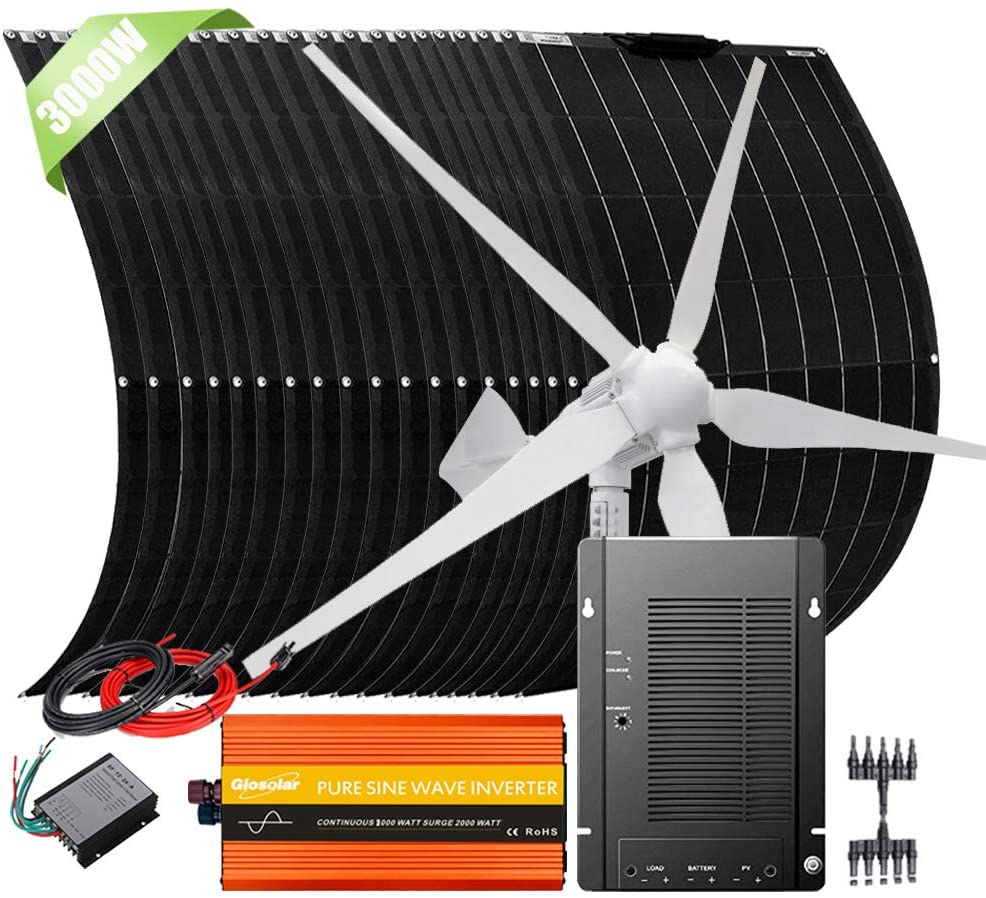
Specifications
| Rated power | 1000 W |
| DC voltage | 48 V |
| Rated speed | 450 rpm |
| Blades number | 5 |
| Rated wind speed | 12 m/s |
| Rotor diameter | 2.2 m |
| Weight | 31 kg |
| Blade material | fiberglass- reinforced plastics |
General Description
The Giosolar 3,000W 48V Hybrid Solar Wind Backup Power Kit can generate power for remote regions in all seasons. It is suitable for both household and commercial applications. The 1000 W wind turbine that can generate power during the day and especially night is combined with solar panels to increase the charging capabilities of the battery.
The number of blades of the wind turbine generator is five rather than the typical three. Starting wind speed is as low as 3-2.5 m/s to collect electricity. The kit is assembled easily. It has a low noise level when working and is sealed to prevent the elements from leaving the turbine housing. The packing is made of foam with a wooden case.
8. Eco-Worthy 1,400W Wind Solar Power Kit
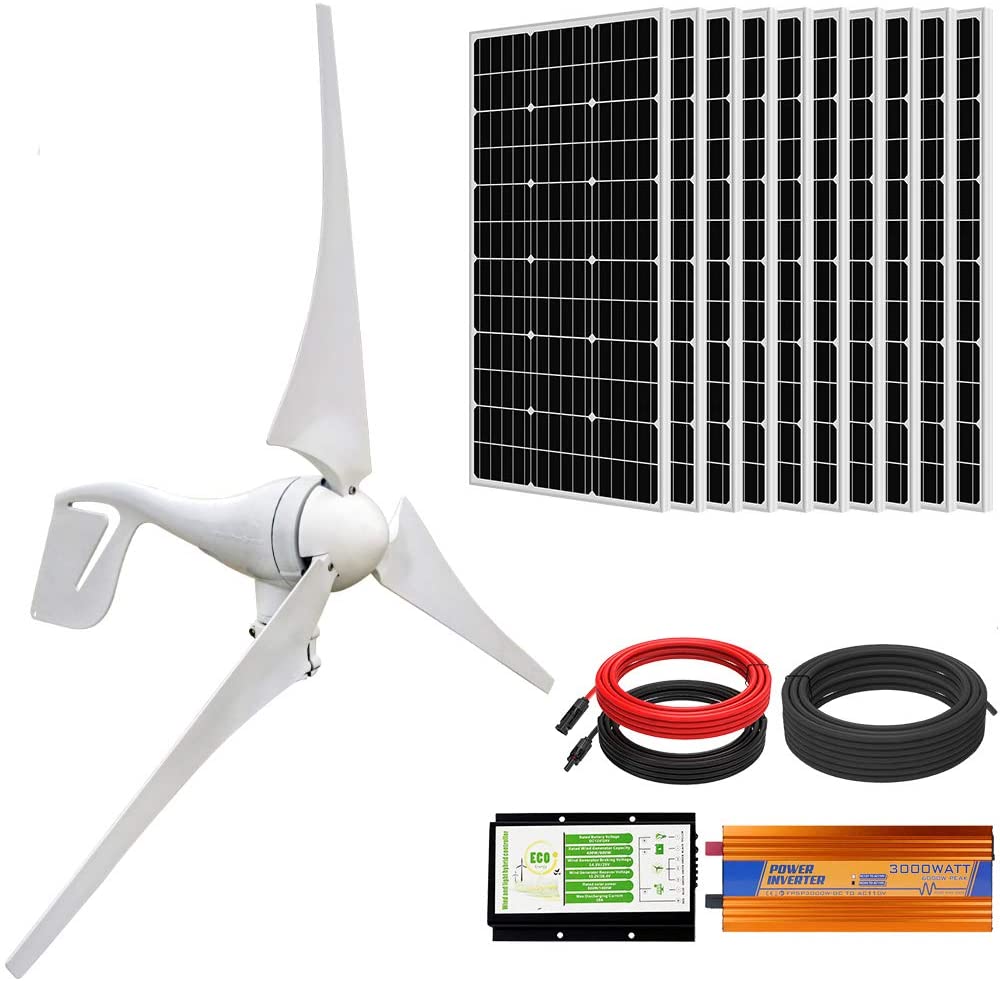
Specifications
| Rated power | 400 W |
| DC voltage | 12-24 V |
| Rated speed | 800 rpm |
| Blades number | 3 |
| Rated wind speed | 10.5 m/s |
| Rotor diameter | 1.2 m |
| Weight | 8 kg |
| Generator material | carbon fiber composite |
General Description
The 1,400W Wind Solar Power Kit made by Eco-Worthy includes several basic components to run your wind turbine. The wind turbine generator has three 24-inch long blades with a somewhat larger than 4-foot diameter.
The housing and blades are made of carbon fiber composite to have excellent durability against adverse weather conditions. A combined 24V wind and the solar hybrid controller is in the kit rated at an 800 W capacity for the wind turbine and 1000 W for the solar panel. The inverter takes 24V DC power and turns to standard 110 Volts AC electricity.
It has high module conversion efficiency with an ideal daily output of 2000Wh per day. Starting wind speed is 2.5 m/s to generate electricity.
9. Auecoor 1,200 Watt Wind and Solar Power Kit
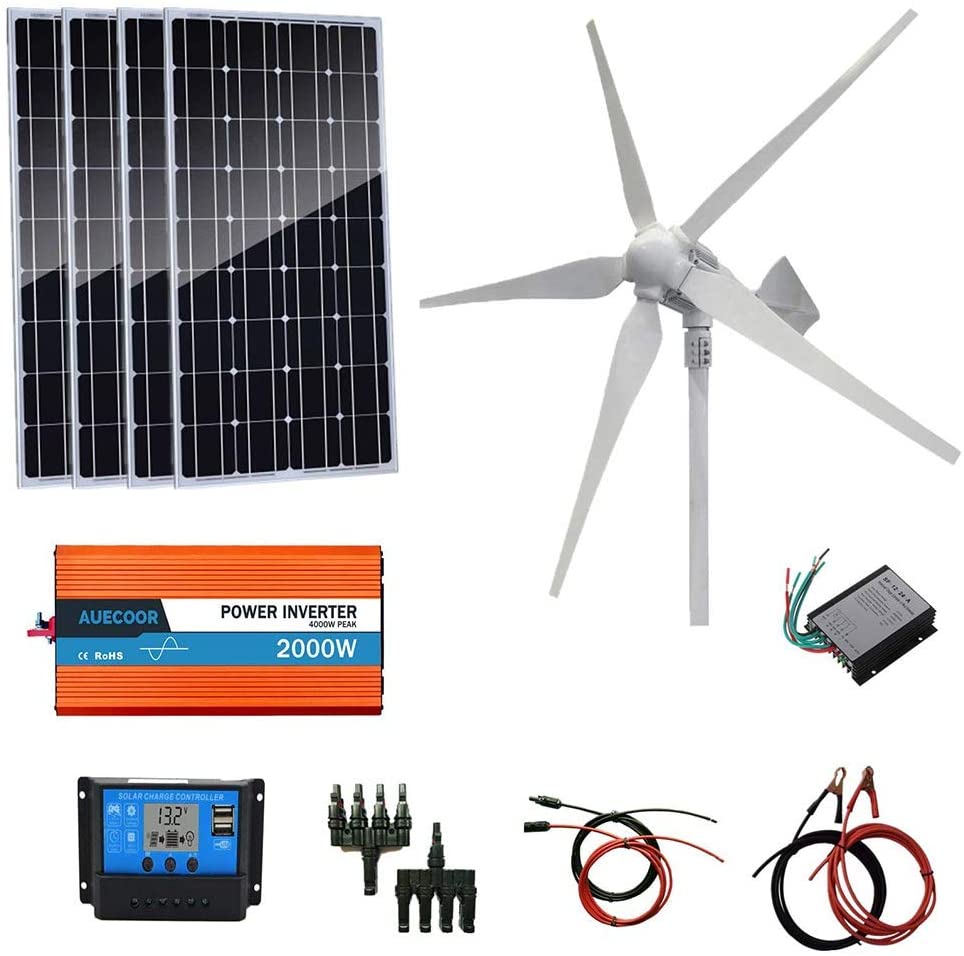
Specifications
| Rated power | 800 W |
| DC voltage | 12 V/24 V/48 V |
| Rated speed | 620 rpm |
| Blades number | 5 |
| Rated wind speed | 12 m/s |
| Rotor diameter | 1.85 m |
| Weight | 28 kg |
| Blades material | fiberglass- reinforced plastics |
General Description
The Auecoor 1,200 Watt Wind and Solar Power Kit has weather-resistant exterior durability. The wind turbine unit has a capacity of 800 Watts. It features five blades with a diameter of a little over six feet. Also, the turbine has a three-phase permanent magnet motor.
The kit features over-speed wind protection, tip stall protection, and electromagnetic brake. Also, equipment surface protection and plastic coating are other specifications of the turbine unit.
10. Tumo-Int 400W Vertical Wind Turbine Generator Kit with Controller
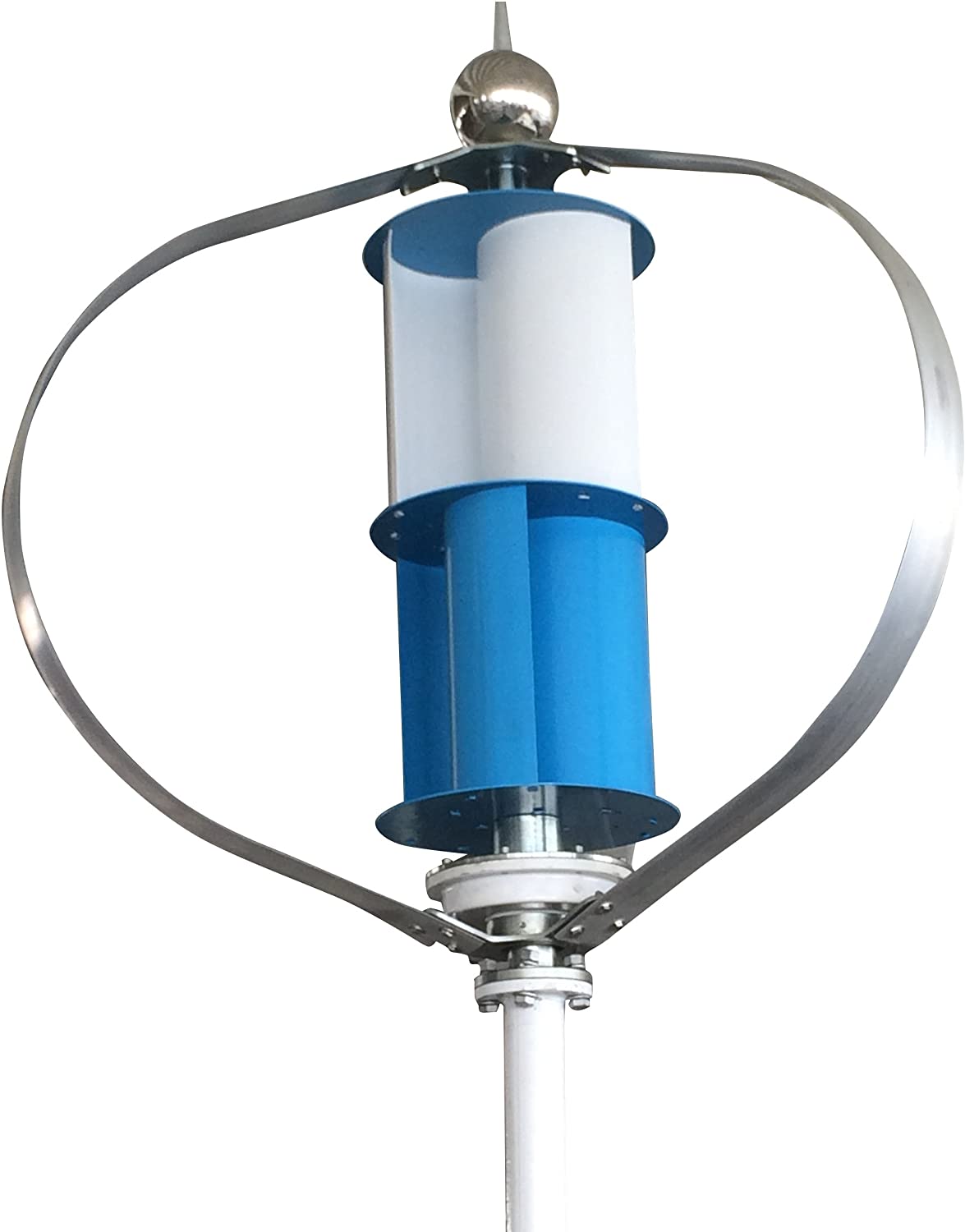
Specifications
| Rated power | 400 W |
| DC voltage | 24 V |
| Rated wind speed | 11 m/s |
| Rotor diameter | 1.4 m |
| Weight | 26 kg |
| Blades material | Casting aluminum alloy |
General Description
The Tumo-Int 400W Vertical Wind Turbine Generator uses a vertical axis. Although this wind turbine generator is a visually stimulating and beneficial unit, it cannot generate as much electricity as some other models discussed in this article. As this is a vertical wind turbine, it does not need to change the direction according to the wind. Additionally, it decreases the resistance towards the wind.
The main cylinder of this vertical type wind turbine consists of curved scoops that capture the wind along with two curved blades. The generator utilizes a permanent magnet rotor alternator with a specially designed stator. So, the resistance torque decreases efficiently. It starts generating electricity at a low wind speed of 2 m/s.
In each unit, an electric controller is included. But, everything else must be purchased separately. This is the biggest weakness of this attractive wind turbine. However, this home wind turbine is still an excellent choice for anyone with a bit of creativity.
11. Pacific Sky Power Survival Wind Turbine Generator

Specifications
| Rated power | 15W max output |
| Product Dimensions | 5″L x 3″W x 1.25″H |
| Rated wind speed | 25 mph |
| Voltage | 12 Volts |
| Weight | 3 Pounds |
| Engine Type | 4 Stroke |
General Description
In an emergency, if you’ve lost electricity or are far from any other power source, the Survival Wind Turbine Generator from Pacific Sky Power can help you power up a phone, laptop, or other small device. It only produces 15W.
This little turbine, which can be folded up to a mere few square inches and weighs just 3 pounds, is great for van living or camping (when you’re off the grid, it never hurts to have a backup for your solar generator). It won’t short out in the rain because it is made to last.
Obviously, if you’re seeking to renovate your home, this is not the type of turbine you want, but it’s a highly practical (and reasonably priced) method to obtain basic emergency electricity anywhere.
12. Ramsond Atlas LM3500 Wind Turbine
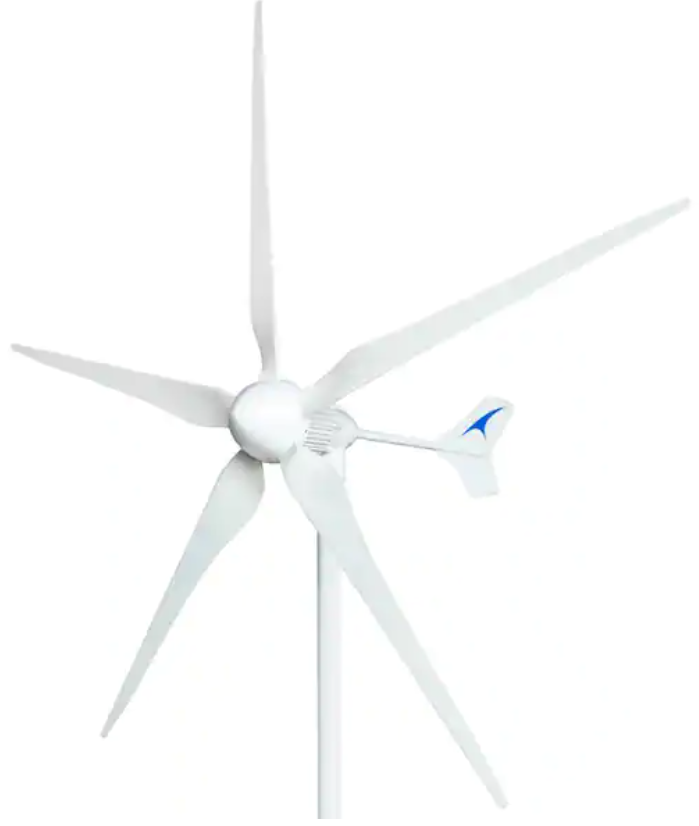
Specifications
| Form factor | Standalone |
| Rated power | 3,000W |
| Start-up wind speed | 4.5 mph |
| Rated wind speed | 28 mph |
| Safe wind speed | 110 mph |
General Description
You’ll need a very large turbine at home if you want to extract the greatest amount of electricity possible from a single wind-based power source. Compared to any of our other selections, Atlas’ 3,000W LM3500 has significantly more power and is exceptionally well made. At less than half its specified wind speed, it can produce 175 kWh a month, or roughly a fourth of the typical power requirements of a residence with low electricity usage.
You should be able to produce enough energy with a couple of these, or with one plus a set of solar panels, to power an off-grid cabin or a farm that needs sporadic electricity. Also, it is well constructed and will deliver dependable performance for many years.
With a weight of somewhat more than 200 pounds, it is neither inexpensive nor light. With its weight, installation won’t be simple either. Nevertheless, if you have a suitable location for it, you’ll have an abundance of dependable electricity.
13. Northern Power Systems – WindGen 1200
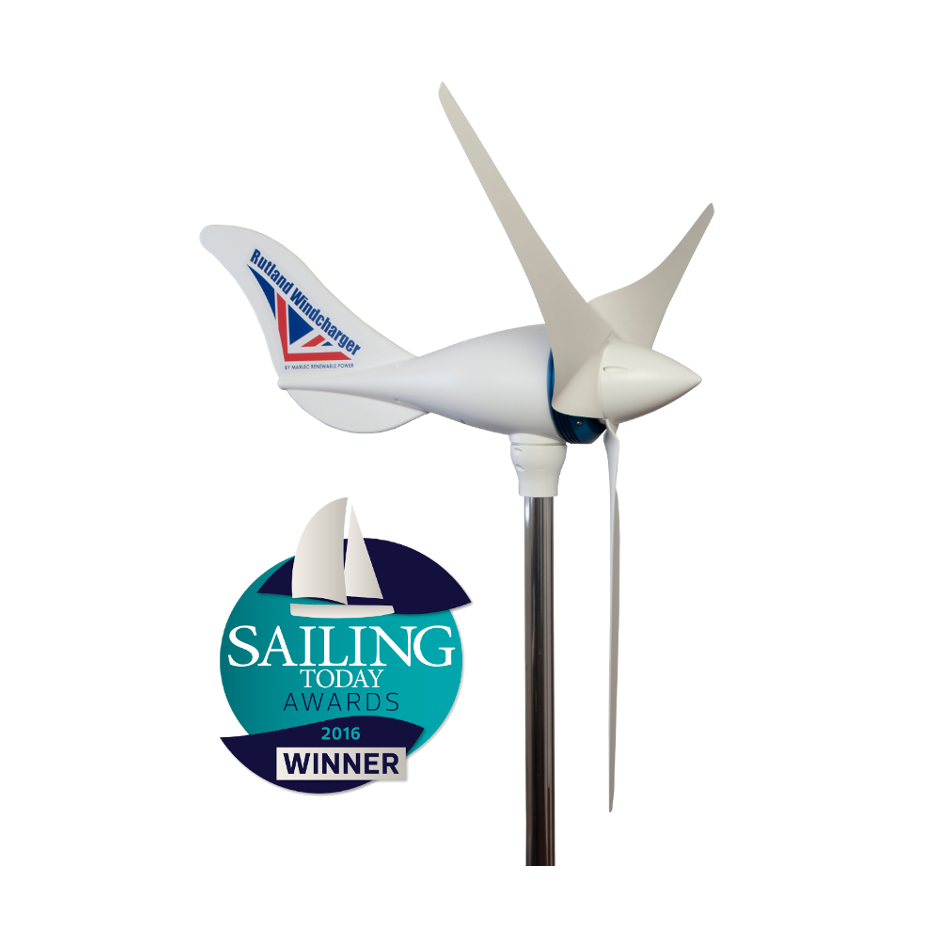
Specifications
| Capacity | 1200 watts |
| Maximum wind speed | 55 mph |
| Blade length | 27 inches |
| Blade material | Fiberglass |
| Rotor diameter | 4.2 feet |
| Tower height | 34 feet |
General Description
The Northern Power System’s WindGen 1200 is a wind turbine designed to generate clean, renewable electricity for residential and commercial use. It features a robust, durable design and high capacity, allowing it to power a home’s lighting, appliances, and electronics. The WindGen 1200 is easy to install and requires minimal maintenance, making it a practical and reliable option for homeowners and businesses alike.
14. Wind & Sun – XLE Series
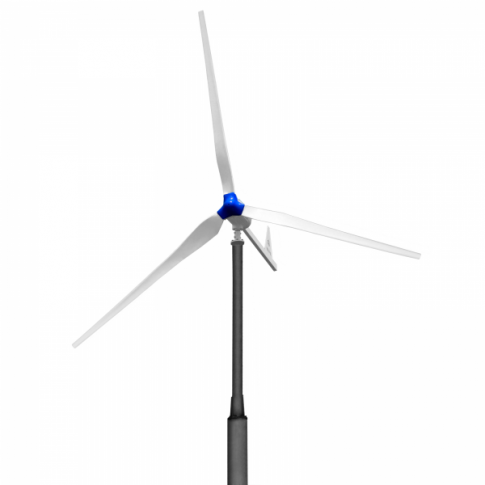
Specifications
| Capacity | 2.5 kilowatt |
| Maximum wind speed | 25 mph |
| Blade length | 2 meters |
| Blade material | Fiberglass |
| Rotor diameter | 20 inches |
| Tower height | 34 feet |
General Description
The Wind & Sun XLE Series is a series of high-performance wind turbines designed to provide clean, renewable energy for residential and commercial use. The turbines are known for their efficiency and durability, making them an ideal option for off-grid and remote applications. The turbines are easy to install and require minimal maintenance, making them an attractive option for homeowners and businesses alike. Despite its high performance, the XLE Series generates a moderate level of noise, so it may not be suitable for use in residential areas. Additionally, the design of the turbines is function over form, which may not appeal to everyone.
15. Bergey Wind Power – BWP-1850
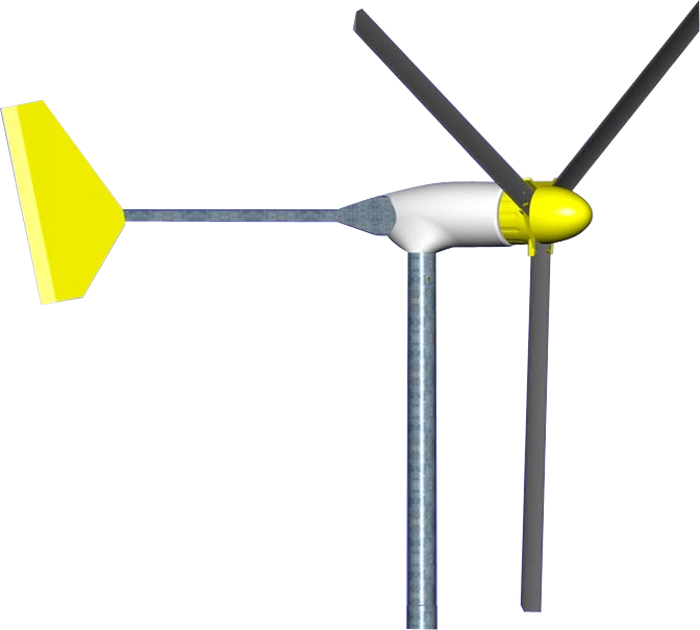
Specifications
| Capacity | 1650 watts |
| Max RPM | 85 |
| Power output | AC or DC |
| Max wind speed | 35 mph |
| Tower height | 80 ft |
General Description
The Bergey Wind Power – BWP-1650 is a wind turbine designed for commercial use. The turbine is designed to be a high-capacity, durable and efficient power source for commercial applications. The BWP-1650 is known for its ease of installation and reliability, making it an attractive option for commercial use. The BWP-1650 requires a strong, consistent wind for optimal performance, which may be a limiting factor in some environments. Despite its high performance, the BWP-1650 generates a moderate level of noise, which may not be suitable for use in residential areas. Additionally, the cost of the BWP-1650 is relatively high compared to other wind turbines, making it less budget-friendly.
Considerations When Selecting Home Wind Turbines
Before purchasing and installing a home wind turbine, there are numerous important things to consider. Before making a purchase, there are a few things you should consider:
How Much Power Do You Require?
It’s critical to have precise information on how much energy your home uses. It helps you to choose which domestic wind turbine is most suited to your electricity requirements.
The Wind Speed In Your Location
You can rapidly determine the size and kind of turbine you require by calculating the quantity and speed of wind near your site. You can choose the finest house wind turbine for you since different home wind turbines have varied power generating capacities.
The wind speed will influence which turbine to purchase, as various turbines have varying start-up wind speeds.
Research on Current Local Zoning Laws
Find out if there are any local rules that might impact or prevent you from installing that turbine. The installation of wind turbines, for example, may be restricted in some towns.
Examine the Certification
You should also check to see if the house wind turbine you’re considering purchasing is certified. The Small Wind Certification Council, an organization entrusted with ensuring that manufacturers only bring high-quality wind turbines to market, certifies them.
You may now purchase your home wind turbine after completing these critical procedures. You can also watch this video to get more information about residential wind turbines.
Working Principle of a Home Wind Turbine
The wind is used to produce a form of useful energy. Wind energy is a type of kinetic energy. Wind turbine takes this kinetic energy from the wind and transforms it into mechanical energy, which can then be converted into electrical power using a generator.
The working principle of the wind turbine is based on turning the energy of the wind into electricity by utilizing the aerodynamic force created by the wind turbine rotating blades. As the wind passes through these blades, the air pressure drops from one side to the side of the blade. So, a pressure difference is created which results in drag and lift forces, similar to flying machines.
The rotor of the wind turbine is connected to a generator via a drive turbine or shaft and gears. The aerodynamic force translates into the rotation of a generator, which then produces useful electricity.
Although according to Mother Earth News, at least one acre of land is needed for the wind turbine to work usefully, it often depends on what wattage you are trying to obtain and also the turbine actual size. However, the important issue that has to be considered while making a decision for the use of a home wind turbine is zoning and local homeowner conditions.
Many of these conditions prevent a user from installing a large turbine powerful enough to run all the household devices in urban areas.
Additionally, the larger space where the turbine is located, the higher the wind speed created and the higher the energy level. Buildings and other constructed objects in an urban yard reduce wind speed that can potentially be used to supply a home wind turbine generator.
But, if you meet the zoning and homeowners requirements, you can still successfully install and employ small wind turbines.
However, if you want to supply your electricity demands totally off the grid, you should consider a combination of wind and solar power to fully power the home, particularly in urban or areas with poor wind conditions.
A parameter that plays an important role in the study of wind turbines is the rating wind speed, which is defined as the speed at which the wind turbine has the maximum output power. For home wind turbines, this value is usually less than 20 m/s. This parameter must be differentiated from the cut-off and the cut-in wind speed.
Home wind turbines usually have a power output in the range of 200 W to 800 W. However, some wind turbines can generate a power output of as much as 2000 W.
To calculate the output of a wind turbine, the following formula is used:
Power=\frac{1}{2}C_{p}\rho AV^{3}
where:
P and Cp are power output (watts) and maximum power coefficient (a dimensionless variable ranging from 0.25 to 0.45 with a theoretical maximum of 0.59). Also, ρ and V are air density (kg/m³) and wind speed (m/s), respectively.
A is the rotor swept area in m² calculated by the following relation:
A=\frac{\pi D^{2}}{4}
D is the rotor diameter in m.
Home Wind Turbine Parts
There are several parts in a full wind turbine kit.

Turbine
Most home wind turbines produced today are similar to those in large wind farms. They include a machine on top of a tall tower with a horizontal axis for installing three blades to rotate a rotor. Blades for home-based units are typically made of a composite material such as fiberglass instead of steel.
The turbine frame is what the other components of the unit are connected to. The amount of energy generated by a turbine depends primarily on the rotor diameter, which determines how much wind can be harnessed by the turbine. A tail placed on the opposite side of the blades holds the turbine facing the wind.
Towers
As stated above, the speed of the wind increases with height. So, the best chance of running a successful wind turbine generator is to install the system on a tower. The higher the tower, the more power produced.
It does not take much cost or attempt to raise the tower height. According to the quantity of power that can be generated, look at this general rule: Raising a 10-kilowatt generator from 60 to 100 feet may cost 10% more, but it can generate 25% more power.
But installing the towers can be difficult. You are faced with a long piece of equipment that must be effectively secured. When you buy a wind turbine kit for home use, you will find that most of them include a tower to build.
There are two types of towers for home wind powers: free-standing (self-supporting) and guyed types. The latter is more common, less expensive, and easier to mount than the other type. The problem is that the guy wires must have a radius of one-half to three-quarters of the height of the tower. Thus, you need ample space to accommodate all the tools.
Self-supporting towers offer a simple approach to conduct maintenance on the turbine. Some self-supporting towers have a tilt-down feature that enables the turbine to be lowered to the ground in hazardous weather such as storms.
Visit here to know more about the design of a tower of a wind turbine.
Other Components
Except for the two mentioned basic parts, other components depend on your needs. Supplying a battery requires different parts compared to a water pumping system.
It is important to check whether the wind power system is connected to the power grid or is wholly off-grid, or even a combination. Depending on these conditions, you can buy the right package for the user.
Suppose that you need a home wind power generator that supplements the existing energy grid. The components you require are
- a controller
- storage batteries
- wiring
- an inverter for conditioning power
- an electrical disconnect switch
- a foundation for the tower
- a grounding system
FAQs about Residential Boilers
How Much Does a Home Wind Turbine Cost?
The cost of a household wind turbine is determined by the kind you choose, the size of the turbine, and who installs it.
A modest roof-mounted turbine (with a capacity of 0.5 to 2.5 kW) costs around 2700$. However, because devices generate relatively little power, it will take a long time to repay those costs.
A free-standing 5kW wind turbine costs between 27,000$ and 35,000$ on average. But keep in mind that you’ll also have to pay for planning approval, site preparation, and connecting your turbine to the power grid. This might raise the total amount to between 40,000$ and 55,000$.
Do I Need Insurance for a Home Wind Turbine?
Your building insurance would cover your wind turbine. To be sure, double-check your policies. If not, you can get a quotation from a professional insurance.
Can I Get Paid For Exporting Energy From My Wind Turbine?
The Feed-in Tariff program used to be a way for people with home energy producers to make money. Unfortunately, the government ended the program in 2018, but the good news is that it was replaced with the Smart Export Guarantee (or SEG).
The SEG compensates you for exporting any energy generated by your wind turbine to the National Grid. If you qualify, you might get SEG payments four times a year. The size of your turbine determines the amount you receive, the amount of power you use, and the amount you export (based on meter readings).
Are Domestic Wind Turbines Worth It?
Wind energy is an ideal method to go green in your house, but it is neither cheap nor simple. Remember to think about these five essential queries before taking the plunge:
- Are you able to install a wind turbine on your property?
- If so, how fast does the wind blow there?
- With the space and wind speed you have, can a wind turbine provide you with enough electricity?
- Is your budget sufficient to cover the upfront costs?
- Will you need construction authorization?
Download Best Home Wind Turbines PDF
You can download this article as a PDF so that you can access it whenever you like.
linquip.com-12 Best Home Wind Turbines Residential in 2024
Watch Videos about Best Home Wind Turbines
For more information about Best Home Wind Turbines, watch this video about Best Home Wind Turbines.
Buy Equipment or Ask for a Service
By using Linquip RFQ Service, you can expect to receive quotations from various suppliers across multiple industries and regions.
Click Here to Request a Quotation From Suppliers and Service Providers
Read More In Linquip
- Top Wind Turbine Manufacturers in USA
- Top Wind Turbine Manufacturers In India (Comprehensive Guide)
- Efficiency of Wind Turbines
- What are Floating Wind Turbines? A Practical Guide to Advantages and Types
- How Do Wind Turbine Generators Work?
- How Fast Does a Wind Turbine Spin? The Surprising Answer
- Types of Wind Turbines: The Quick and Easy Intro
- What is Wind Turbine? The Short and Essential Answer

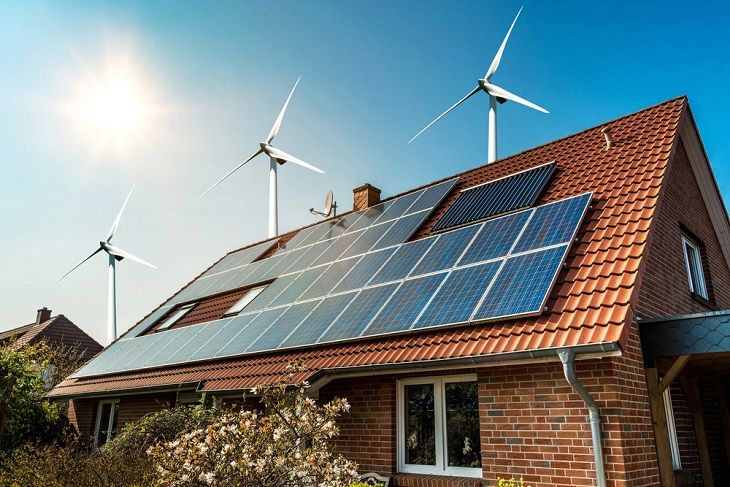


I want tu install wind turbine so kindely tell me the price of 1500w wind turbine
1500w wind turbine price
Thanks for visiting our website, Muhammad! You can visit our Wind Turbine Equipment Page, where you can find various wind turbines based on your requirement and get quotations from the suppliers.